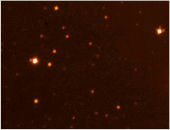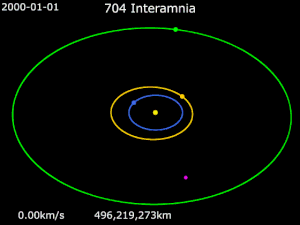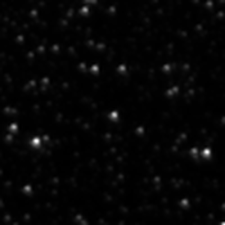astro.wikisort.org - Asteroid
704 Interamnia is a large F-type asteroid. With a mean diameter of around 330 kilometres, it is the fifth-largest asteroid, after Ceres, Vesta, Pallas and Hygiea. Its mean distance from the Sun is 3.067 (AU). It was discovered on 2 October 1910 by Vincenzo Cerulli, and named after the Latin name for Teramo, Italy, where Cerulli worked. Its mass is probably between fifth and tenth highest in the asteroid belt, with a mass estimated to be 1.2% of the mass of the entire asteroid belt.[6] Observations by the Very Large Telescope's SPHERE imager in 2017–2019, combined with occultation results, indicate that the shape of Interamnia may be consistent with hydrostatic equilibrium for a body of its density with a rotational period of 7.6 hours. (Its current period is 8.7 hours.) This suggests that Interamnia may have formed as an equilibrium body, and that impacts changed its rotational period after it fully solidified.[4]
 | |
| Discovery | |
|---|---|
| Discovered by | Vincenzo Cerulli |
| Discovery date | 2 October 1910 |
| Designations | |
MPC designation | (704) Interamnia |
| Pronunciation | /ɪntərˈæmniə/[1] |
Named after | Teramo |
Alternative designations | 1910 KU; 1952 MW |
Minor planet category | Main belt |
| Adjectives | Interamnian /ɪntərˈæmniən/[1] |
| Orbital characteristics[2] | |
| Epoch July 01, 2021 (JD 2459396.5, heliocentric) | |
| Uncertainty parameter 0 | |
| Observation arc | 110.8 yr |
| Aphelion | 3.53 AU (528 Gm) |
| Perihelion | 2.58 AU (386 Gm) |
Semi-major axis | 3.056 AU (457.2 Gm) |
| Eccentricity | 0.155 |
Orbital period (sidereal) | 5.34 yr (1951 d) |
Average orbital speed | 16.92 km/s[citation needed] |
Mean anomaly | 248° |
Mean motion | 0° 11m 4.2s / day |
| Inclination | 17.31° |
Longitude of ascending node | 280.3° |
Argument of perihelion | 94.8° |
| Physical characteristics | |
| Dimensions | c/a = 0.86±0.03[3] 362 × 348 × 310 ± 8 km[4] |
Mean diameter | 332±5 km[3]
332±6 km (volume equivalent)[4] |
| Mass | (35±5)×1018 kg[3] (38±13)×1018 kg[4] |
Mean density | 1.84±0.28 g/cm3[3] 2.0±0.7 g/cm3[4] |
Synodic rotation period | 8.71 h[4] |
Pole ecliptic latitude | 62±5° |
Pole ecliptic longitude | 87±5° |
Geometric albedo | 0.067[3] 0.078±0.014 geometric (0.645±0.014 BV, 0.259±0.021 UB)[2] |
Spectral type | F/B[2] |
Apparent magnitude | 9.9 to 13.0[5] |
Absolute magnitude (H) | 6.38[2] |
Characteristics


Although Interamnia is the largest asteroid after the "big four", it is a very little-studied body. It is easily the largest of the F-type asteroids, but until 2017-2019 there existed very few details of its internal composition or shape, and no light curve analysis has yet been done to determine the ecliptic coordinates of Interamnia's poles (and hence its axial tilt). Studies by the Very Large Telescope give an average diameter of about 332 km and found an ellipsoidal shape for Interamnia, similar to 4 Vesta; the resulting density calculation (1.98 ± 0.68 g·cm−3) is not precise enough to definitely infer Interamnia's composition, but the presence of hydrated materials at the surface and its overall spectral similarities to Ceres suggest that it is likely an icy body. The absence of an affiliated asteroid family implies that Interamnia has not suffered a giant impact within the past 3 billion years,[7] in contrast to 4 Vesta and 10 Hygeia.[8][9]
Its very dark surface and relatively large distance from the Sun means Interamnia can never be seen with 10x50 binoculars. At most oppositions its magnitude is around +11.0, which is less than the minimum brightness of Vesta, Ceres or Pallas. Even at a perihelic opposition its magnitude is only +9.9,[5] which is over four magnitudes lower than Vesta.
Its orbit is slightly more eccentric than that of Hygiea (15% versus 12%) but differs from Hygiea's in its much greater inclination and slightly shorter period. Another difference is that Interamnia's perihelion is located on the opposite side from the perihelia of the "big four", so that Interamnia at perihelion is actually closer to the Sun than Ceres and Pallas are at the same longitude. It is unlikely to collide with Pallas because their nodes are located too far apart, whilst although its nodes are located on the opposite side from those of Ceres, it is generally clear of Ceres when both cross the same orbital plane and a collision is again unlikely.[original research?]
Surface
There are no deep basins visible in the VLT images. Any large craters must have flat floors, consistent with an icy C/F-type composition.[10]
Mass
In 2001, Michalak estimated Interamnia to have a mass of (7±2)×1019 kg. Michalak's estimate depends on the masses of 19 Fortuna, 29 Amphitrite, and 16 Psyche; thus this mass was obtained assuming an incomplete dynamical model.[11]
In 2011, Baer calculated Interamnia had a mass of (3.9±0.2)×1019 kg.[12]
Goffin's 2014 astrometric reanalysis gives an even lower mass of (2.7±0.1)×1019 kg.[13]
In 2019, Hanuš et al. consolidated 21 selected prior mass estimates, dating from 1992 to 2017, with a metastatistical result of (3.8±1.3)×1019 kg (that is, (2.5 to 5.1)×1019 kg to within 1 sigma uncertainty.[4]
- VLT-SPHERE image of Interamnia
 Animation of 704 Interamnia's orbit 2000-2020
Animation of 704 Interamnia's orbit 2000-2020
Sun · Earth · Mars · Jupiter · 704 Interamnia The Transiting Exoplanet Survey Satellite (TESS) observed 704 Interamnia passing close to a target star, TIC 14802783, on 18/01/19.
The Transiting Exoplanet Survey Satellite (TESS) observed 704 Interamnia passing close to a target star, TIC 14802783, on 18/01/19.
See also
- List of Solar System objects by size
References
- "interamnian". Oxford English Dictionary (Online ed.). Oxford University Press. (Subscription or participating institution membership required.)
- JPL data Retrieved 2021-09-29
- P. Vernazza et al. (2021) VLT/SPHERE imaging survey of the largest main-belt asteroids: Final results and synthesis. Astronomy & Astrophysics 54, A56
- Hanuš, J.; Vernazza, P.; Viikinkoski, M.; Ferrais, M.; Rambaux, N.; Podlewska-Gaca, E.; et al. (2020). "(704) Interamnia: A transitional object between a dwarf planet and a typical irregular-shaped minor body". Astronomy & Astrophysics. 633: A65. arXiv:1911.13049. Bibcode:2020A&A...633A..65H. doi:10.1051/0004-6361/201936639. S2CID 208512707.
- "Bright Minor Planets 2007". Minor Planet Center. Retrieved 21 May 2008.[permanent dead link]
- Pitjeva, E. V. (2005). "High-Precision Ephemerides of Planets—EPM and Determination of Some Astronomical Constants" (PDF). Solar System Research. 39 (3): 176–186. Bibcode:2005SoSyR..39..176P. doi:10.1007/s11208-005-0033-2. S2CID 120467483. Archived from the original (PDF) on 31 October 2008. 15 = 0.0124
- Hanuš, J.; Vernazza, P.; Viikinkoski, M.; Ferrais, M.; Rambaux, N.; Podlewska-Gaca, E.; Drouard, A.; Jorda, L.; Jehin, E.; Carry, B.; Marsset, M.; Marchis, F.; Warner, B.; Behrend, R.; Asenjo, V.; Berger, N.; Bronikowska, M.; Brothers, T.; Charbonnel, S.; Colazo, C.; Coliac, J.-F.; Duffard, R.; Jones, A.; Leroy, A.; Marciniak, A.; Melia, R.; Molina, D.; Nadolny, J.; Person, M.; et al. (2020). "(704) Interamnia: A transitional object between a dwarf planet and a typical irregular-shaped minor body". Astronomy & Astrophysics. 633: A65. arXiv:1911.13049. Bibcode:2020A&A...633A..65H. doi:10.1051/0004-6361/201936639. S2CID 208512707.
- Schenk, P.; O'Brien, D. P.; Marchi, S.; Gaskell, R.; Preusker, F.; Roatsch, T.; Jaumann, R.; Buczkowski, D.; McCord, T.; McSween, H. Y.; Williams, D.; Yingst, A.; Raymond, C.; Russell, C. (2012). "The Geologically Recent Giant Impact Basins at Vesta's South Pole". Science. 336 (6082): 694–697. Bibcode:2012Sci...336..694S. doi:10.1126/science.1223272. PMID 22582256. S2CID 206541950.
- Vernazza, P.; Jorda, L.; Ševeček, P.; Brož, M.; Viikinkoski, M.; Hanuš, J.; Carry, B.; Drouard, A.; Ferrais, M.; Marsset, M.; Marchis, F.; Birlan, M.; Podlewska-Gaca, E.; Jehin, E.; Bartczak, P.; Dudzinski, G.; Berthier, J.; Castillo-Rogez, J.; Cipriani, F.; Colas, F.; DeMeo, F.; Dumas, C.; Durech, J.; Fetick, R.; Fusco, T.; Grice, J.; Kaasalainen, M.; Kryszczynska, A.; Lamy, P.; Le Coroller, H.; Marciniak, A.; Michalowski, T.; Michel, P.; Rambaux, N.; Santana-Ros, T.; Tanga, P.; Vachier, F.; Vigan, A.; Witasse, O.; Yang, B.; Gillon, M.; Benkhaldoun, Z.; Szakats, R.; Hirsch, R.; Duffard, R.; Chapman, A.; Maestre, J. L. (February 2020). "A basin-free spherical shape as an outcome of a giant impact on asteroid Hygiea" (PDF). Nature Astronomy. 4 (2): 136–141. Bibcode:2020NatAs...4..136V. doi:10.1038/s41550-019-0915-8. S2CID 209938346. Retrieved 30 March 2022.
- Hanuš et al. 2020
- Michalak, G. (2001). "Determination of asteroid masses". Astronomy & Astrophysics. 374 (2): 703–711. Bibcode:2001A&A...374..703M. doi:10.1051/0004-6361:20010731.
- Baer, James (2010). "Recent Asteroid Mass Determinations". Personal Website. Archived from the original on 2 July 2013. Retrieved 13 February 2011.
- Goffin, Edwin (2014). "Astrometric asteroid masses: A simultaneous determination". Astronomy & Astrophysics. 565: A56. arXiv:1402.4241. Bibcode:2014A&A...565A..56G. doi:10.1051/0004-6361/201322766. S2CID 118444915.
External links
- Animation of Asteroid Interamnia taken on 1 & 2 April 2003
- Interamnia Occultations Observed before 2003
- Occultation of GSC 23450183 by 704 Interamnia on 17 December 1996
- Occultation of HIP36189 by 704 Interamnia on 23 March 2003
- (704) Interamnia: A transition object between a dwarf planet and a typical irregular-shaped minor body
- 704 Interamnia at AstDyS-2, Asteroids—Dynamic Site
- 704 Interamnia at the JPL Small-Body Database
На других языках
[de] (704) Interamnia
(704) Interamnia ist ein Asteroid des äußeren Asteroiden-Hauptgürtels, der am 2. Oktober 1910 von Vincenzo Cerulli an dessen Privatsternwarte in Teramo (Italien) entdeckt wurde. Benannt wurde er nach dem antiken römischen Namen von Teramo, Interamnia.- [en] 704 Interamnia
[es] (704) Interamnia
(704) Interamnia es un asteroide que forma parte del cinturón de asteroides y fue descubierto el 2 de octubre de 1910 por Vincenzo Cerulli desde el observatorio astronómico de Collurania en Teramo, Italia.[ru] (704) Интерамния
(704) Интерамния (лат. Interamnia) — один из крупнейших астероидов главного пояса размером 326 км[4][5], принадлежащий к редкому спектральному классу F. Интерамния входит в пятёрку самых крупных и массивных астероидов главного пояса, уступая по массе лишь Церере, Весте, Палладе и Гигее, она имеет массу составляющую 1,2 % массы всех астероидов между орбитами Марса и Юпитера[6], а именно 3,9⋅1019 кг[7].Другой контент может иметь иную лицензию. Перед использованием материалов сайта WikiSort.org внимательно изучите правила лицензирования конкретных элементов наполнения сайта.
WikiSort.org - проект по пересортировке и дополнению контента Википедии


